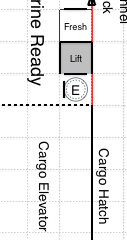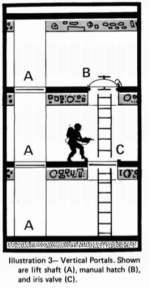So if you've got a Grav Lift, you ALSO need to have a backup separate vertical iris valve or hatch because ONLY THOSE have ladders!
(points at picture and smirks)

(points to picture and smirks)
My design could of course be criticised for having the main emergency ladder-and-hatch too close to the lift shaft. In case of e.g. combat damage they might both be disabled simultaneously. But there are other emergency hatches, enough that the design could be criticised for having too many external hatches, making it too easy to break in.
Except in published deck plans featuring lifts (such as LBB S7, for example) you don't always see redundant vertical access points between decks as a backup to the grav lift in case power fails.
Whoever said all published designs are good designs? They are mostly silly, ruled by the power of cool, just like the Type T: There is no reason to make it so long and thin, especially with the winglets interfering with landing. It's not a practical design, it just looks cool, very cool.
(checks Express Tender, just to be sure)
Yup, there it is.
3 out of 5 decks shown have no redundant vertical access other than ... a second grav lift.
And I would call that bad, too. There is an iris valve between the top two decks, that might be forced open in an emergency.
The Marava on the other hand has plenty of hatches, both between decks, and out of the ship. I could wish for a hatch, not just three iris valves between the Engineering decks.
Zero-G transfer from the small craft to the hold with the small craft outside the ship and the door open.
How do you do it?
So, you must stop the ship accelerating, EVA, and manually push 50 tonne containers into space, manhandle them (against 50 tonnes of inertia) into the cargo hold as they suddenly regain weight as they enter the ship. That sounds convenient...
I would dock the small craft, open the cargo hatch, push the container horizontally onto the cargo elevator (using a 53rd century fork lift), lower it to the hold, and push the container into place in the hold, all in a shirt-sleeve environment, while the ship is manoeuvring at will. Somehow that seems simpler and less accident-prone to me...
A grav vehicle merely needs an egress point. It's a GRAV vehicle ... it can move in all 3 axes without requiring aerodynamic flow in order to do so. If the grav vehicle is positioned to exit the craft simply by opening an exterior door, that's all that's needed ... whether that exterior door is at a planetary surface or in space. Interior access happens ... well ... from the, you know ... interior spaces.
Yes, an air/raft can be kicked out in orbit and deorbit itself in a few hours, putting the passengers into vacuum.
Or, you could load the air/raft into the provided small craft, seat the passengers into comfy seats, serve them drinks that they barely have time to drink, as you deorbit in a few minutes, all in a shirt-sleeve environment.
Or, since it's a military ship, the small craft can perform a quick combat drop in minutes, deposit troops and vehicles on top of the objective, protected by basic space armour, instead of having a GCarrier slowly descend in hours, a sitting duck for any defensive fire.
The vehicle in question might also be an ATV, less able to deorbit itself in one piece.
A small craft is all about convenience, it should be convenient to use it instead of the ship itself, to transport people or cargo as needed. To transport people and cargo between ships, stations, and space ports without exposing anyone or anything to vacuum, without having to dock or land the ship itself.





